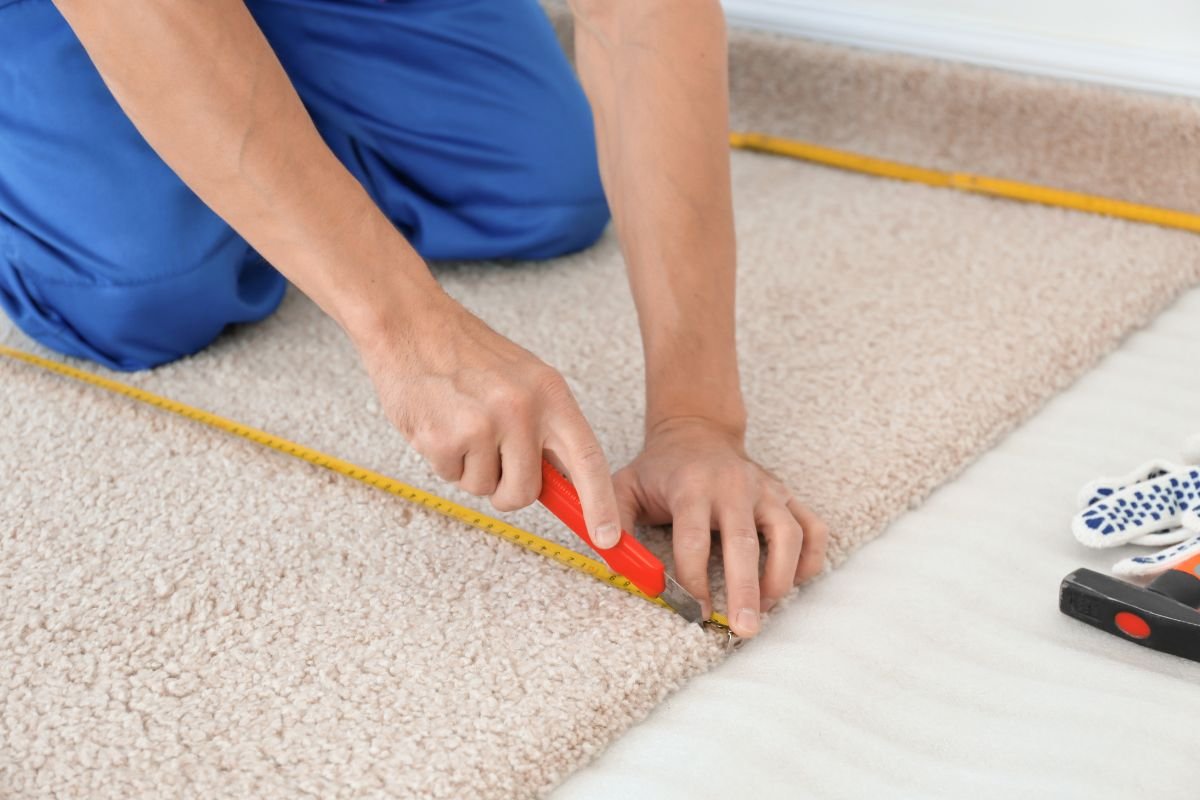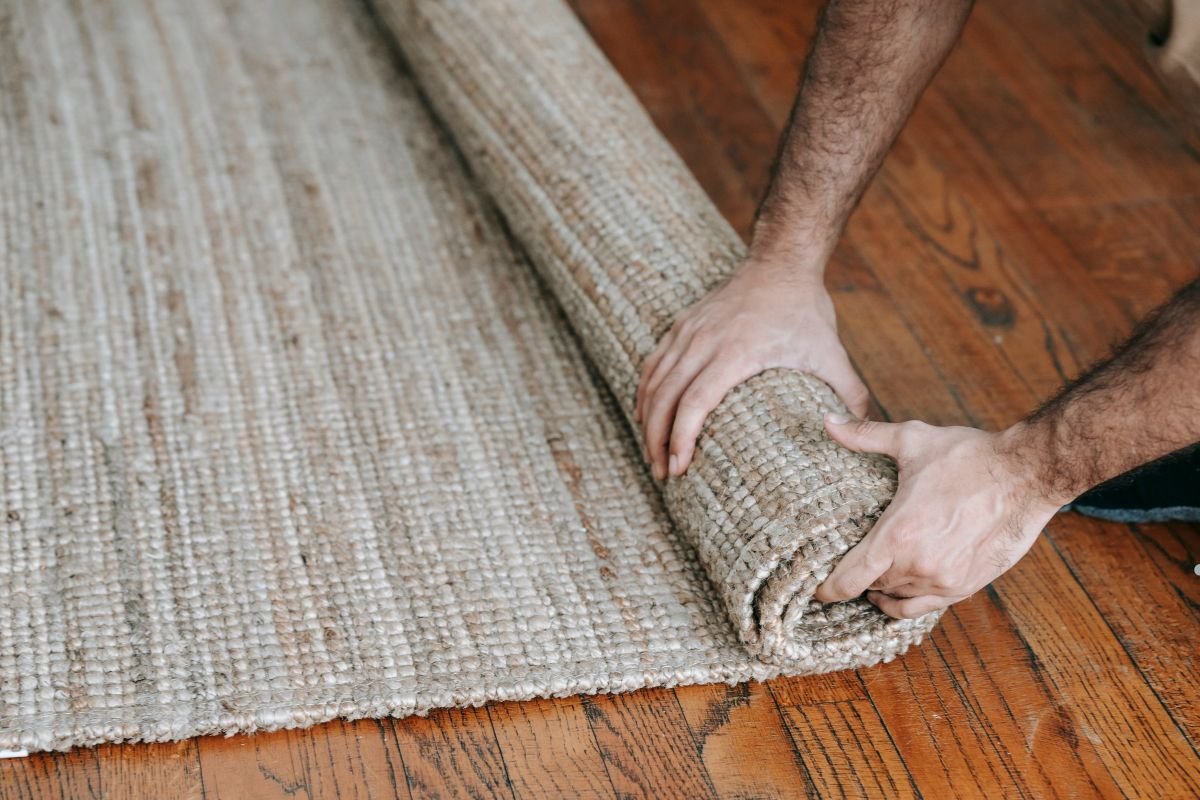
Getting new carpet installed is exciting, but you might be wondering how soon you can start using the room. Whether it’s your living room, bedroom, or office, knowing the right steps to take after installation is key to keeping your carpet in great shape. In this guide, we’ll break down everything you need to know about waiting times, preparation, and post-installation care.

Key Takeaways
- Wait at least 24-48 hours before heavy use if adhesive was used during installation.
- For tack-strip installations, light foot traffic is okay immediately, but avoid moving furniture right away.
- Proper ventilation helps get rid of new carpet smells faster and improves air quality.
- Use furniture pads to prevent dents and protect high-traffic areas with rugs or mats.
- Avoid steam cleaning or exposing the carpet to moisture for at least two weeks.
Understanding the Waiting Period After Carpet Installation
Factors That Influence the Waiting Time
The time you need to wait before using a newly carpeted room depends on a few key factors. The installation method plays the biggest role. For instance:
- Tack strip installation: You can usually walk on the carpet right away, but avoid wearing shoes or dragging heavy furniture for the first 24-48 hours.
- Glue-down installation: This method requires more patience. It’s best to wait 24 to 72 hours to allow the adhesive to fully cure. Walking on it too soon can cause bubbling or uneven bonding.
- Humidity and temperature: These environmental factors can either speed up or slow down the curing process for glue-down carpets.
If you’re unsure, always check with your installer for specific recommendations based on your carpet type and installation method.
Differences Between Tack Strip and Glue-Down Methods
Here’s a quick breakdown of how these two common installation methods differ:
| Installation Method | Waiting Time to Use | Special Considerations |
| Tack Strip | Immediate (with care) | Avoid shoes and heavy furniture for 24 hours. |
| Glue-Down | 24-72 hours | Ensure no foot traffic to allow proper adhesive curing. |
Tack strip installations are quicker to settle, but they still require gentle handling in the first day or so. Meanwhile, glue-down methods demand a bit more patience to ensure a long-lasting, smooth finish.
Why Proper Adhesive Curing Is Essential
When adhesives are involved, curing time is not something to rush. The curing process ensures the glue forms a strong bond between the carpet and the subfloor. If you walk on or move furniture over the carpet too early, you risk:
- Bubbling or rippling of the carpet surface.
- Weak adhesive bonds, leading to long-term wear issues.
- Uneven settling, which could require costly repairs.
Giving your carpet the right amount of time to settle ensures a flawless finish and extends its longevity. A little patience now can save you headaches down the road.
For glue-down installations, adhesives used in carpet installation are designed to fully set within 24 to 72 hours. Following these guidelines will help you avoid common pitfalls and keep your carpet looking its best.
Preparing Your Room for Carpet Installation
Clearing the Space for a Smooth Installation
Before the installers arrive, clearing out the room is the first and most important step. Remove all furniture, decorations, and items from the area where the carpet will be installed. Don’t overlook closets or storage spaces within the room. If you have large or heavy furniture that’s difficult to move, consult your installation team—they might help or advise you on how to manage these items. Leaving the room completely empty ensures the installation process goes smoothly and avoids delays. For more details, check out our carpet tile flooring.
Inspecting and Cleaning the Subfloor
Once the old tile flooring is removed, take a good look at the subfloor. Sweep or vacuum it thoroughly to remove any dust or debris. This is also the perfect time to inspect for damage. Look for cracks, uneven spots, or signs of moisture—these issues need to be fixed before the new carpet goes in. A clean, level subfloor is essential for a proper installation and a long-lasting carpet. Learn more about Tile Flooring
Trimming Door Frames and Baseboards
Sometimes, the height of the new carpet and padding requires adjustments to door frames and baseboards. Use a handsaw or oscillating tool to trim the bottom of door frames, allowing the carpet to fit snugly underneath. Baseboards might need to be removed or adjusted, depending on the situation. Discuss this with your installer to decide the best approach. Taking care of these details ahead of time gives your room a polished, professional look.
Managing the Initial Days After Installation
Allowing the Carpet to Settle Properly
Right after installation, your carpet needs a bit of time to adjust. If your carpet was installed using tack strips, you can walk on it immediately, but avoid wearing shoes or dragging furniture for the first few hours. For glue-down installations, it’s best to wait 24 to 48 hours before stepping on the carpet to ensure the adhesive sets properly. During this settling period, the carpet fibers relax, and any minor wrinkles or waves naturally smooth out. If you’ve got heavy furniture, give the carpet at least 24 hours before moving items back to avoid permanent dents. Use furniture pads to evenly distribute weight when you do.
Dealing with New Carpet Odors
That “new carpet smell” is totally normal and comes from the release of VOCs (volatile organic compounds). While harmless, the odor can be annoying. To clear the air, open windows and run fans for ventilation. If you’re sensitive to smells, plan to avoid heavy use of the room for 48 to 72 hours. This simple step ensures a more comfortable environment as the odor fades.
Protecting High-Traffic Areas
In the first few days, your carpet is more vulnerable to wear and tear. Protect busy areas by using temporary mats, runners, or rugs. This is especially useful if you have kids or pets running around. Also, avoid introducing moisture, like steam cleaning, for at least 30 days to let the carpet fully settle.
Ensuring a Safe Environment During Installation
Keeping Children and Pets Away
Carpet installation can be messy and noisy. It’s not the safest space for kids or pets during this time. To avoid accidents or interruptions, consider arranging for them to stay with family or friends. If that’s not an option, set up a designated safe zone in your home, far from the work area. This will keep them entertained and out of harm’s way.
Securing Fragile and Valuable Items
Before the installation begins, take a moment to remove any fragile or valuable items from the room. Pack away delicate decorations, take down wall-mounted pictures, and relocate anything that could be affected by vibrations or foot traffic. This small step can save you a lot of stress—better safe than sorry!
Planning for Adequate Ventilation
Carpet installations often involve adhesives or other materials that can release strong odors. To keep your indoor air fresh, make sure to open windows and use fans to circulate air. Ventilation can help reduce any lingering smells, making your home more comfortable once the job is done.
Taking these precautions not only protects your loved ones and belongings but also ensures a smoother installation process for everyone involved.

Post-Installation Care for Long-Lasting Results
Vacuuming and Cleaning Tips
Right after your carpet is installed, it might look perfect, but that doesn’t mean it’s maintenance-free. Start by vacuuming your carpet within the first 48 hours to remove any loose fibers left from the installation process. Regular vacuuming is key—aim for at least once a week using a vacuum cleaner with a beater bar or rotating brush. This helps keep your carpet clean and prevents dirt from settling deep into the fibers. If you’re unsure about the best vacuum for your carpet, check the manufacturer’s recommendations.
Avoiding Moisture and Steam Cleaning
For the first two weeks, avoid exposing your carpet to any form of moisture or steam. This allows the adhesive to fully cure and ensures the carpet remains securely in place. Introducing water too soon can weaken the bond and potentially cause damage. If you need to clean a spill, blot it gently with a dry cloth—don’t rub.
Using Furniture Pads to Prevent Dents
Heavy furniture can leave unsightly dents in your new carpet. To avoid this, use furniture pads under the legs of chairs, tables, and sofas. These small pads distribute the weight more evenly and protect the carpet fibers from being permanently compressed. If dents do appear, you can fluff the fibers back up by gently rubbing them with your fingers or using a spoon.
Making the Most of Your New Carpet
Choosing the Right Carpet for Your Lifestyle
Picking the right carpet isn’t just about looks—it’s about how it fits into your daily life. Do you have kids running around or pets that shed like crazy? Then you’ll want something durable and easy to clean. For quieter homes, softer, plush carpets can add a touch of luxury. Think about how you use the space before making a decision.
Here’s a quick breakdown of carpet types and their best uses:
| Carpet Type | Best For |
| Nylon | High-traffic areas, stain-resistant |
| Polyester | Soft feel, budget-friendly |
| Wool | Eco-friendly, luxurious look |
| Olefin | Basements, moisture-prone areas |
Understanding Transition Strips and Thresholds
When your carpet meets another type of flooring, like tile or hardwood flooring, you’ll need a transition strip or threshold. These aren’t just for looks—they protect the edges of your carpet and prevent tripping hazards. Talk to your installer about your options, whether it’s a subtle metal strip or a more decorative wood threshold. Proper transitions can make your flooring look seamless while keeping it functional. Learn more about hardwood flooring
Tips for Maintaining Carpet Longevity
Your new carpet is an investment, so take care of it! Here are a few tips to keep it looking fresh:
- Vacuum regularly to prevent dirt buildup.
- Implement a no-shoes policy to reduce wear and tear.
- Spot clean spills immediately to avoid stains.
- Rearrange your furniture occasionally to prevent dents in the carpet.
- Extend the life of your carpet by following maintenance tips like cleaning air ducts and avoiding excessive moisture.
A little effort in maintenance goes a long way. Your carpet will thank you by staying plush and vibrant for years to come.
By choosing the right carpet, planning for transitions, and staying on top of maintenance, you’ll enjoy a cozy, beautiful floor that enhances your home’s comfort and style. If you need assistance or have any questions, feel free to Call Us.
Conclusion
Getting a new carpet is exciting, but knowing when and how to use the room afterward is just as important. Whether it’s giving the adhesive time to set, letting the carpet settle, or simply airing out the space, a little patience goes a long way. By following these tips, you’ll ensure your carpet stays in great shape and your room feels fresh and ready for use. Take your time, enjoy the process, and soon enough, your space will be as cozy and inviting as you imagined.
Frequently Asked Questions
How long should I wait before using a newly installed carpet?
For tack strip installations, you can usually walk on the carpet immediately, but it’s best to avoid wearing shoes or dragging furniture for the first few hours. For glue-down installations, wait 24 to 48 hours to ensure the adhesive cures properly. If you have any questions, don’t hesitate to Call Us.
What can I do to get rid of the new carpet smell?
The smell comes from VOCs (volatile organic compounds) released by the carpet. Ventilate the room by opening windows and using fans. Most odors will fade within a few days.
Do I need to clear the room before carpet installation?
Yes, you should remove all furniture, decorations, and items from the room. If you have heavy furniture, discuss moving options with the installer beforehand.
Why is subfloor preparation important before carpet installation?
A clean and even subfloor ensures the carpet lays smoothly and lasts longer. Any dirt, debris, or damage could affect the installation quality.
How can I protect my carpet in high-traffic areas?
Use temporary mats or runners in high-traffic zones during the first few days. This helps minimize wear and tear while the carpet settles.
Can I steam clean a newly installed carpet?
Avoid steam cleaning for at least two weeks after installation. This allows the adhesive to cure fully and prevents moisture from damaging the carpet. If you have any questions or need assistance, feel free to Contact Us

